Hi all,
after having learned a lot by just reading the incredibly smart and well-researched stuff posted on dipoles and OB design around here, I decided to take the next step and start my first OB project.
First, I'll be evaluating if the drivers I've got already lying around here may be suited for the project, especially in terms of their capability for constant directivity. I'll post my finding as they come in and hope you can give me some feedback on how to proceed!
Today I took some rough on- and off-axis measurements of my little KEF iQ3s. Since the enclosures are already a bit battered and I'm not really happy with them anyway, I might consider to take them apart and use just the good parts - which, as it turns out, could be the coax drivers.
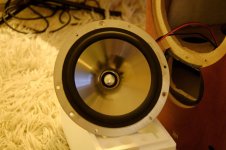
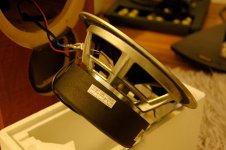
They seem to exhibit some nice constant directivity (measurements taken at eyeballed 0°, 15°, 30°, 45°, 60°, 75° and 90° - I obviously didn't quite manage to keep measurement distance constant):
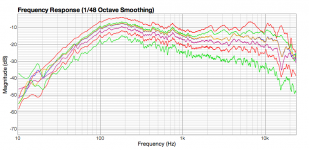
This is some quite nice off-axis response, don't you think?
The question now is: Would those drivers be suited for an OB speaker? Two obstacles will be the large magnetic shielding and the closed back of the tweeters... Maybe both could be removed.
I could only obtain the following parameters for them from teh Interwebs:
Power Handling: 15 - 120 Watts
Nominal Impedance: 8 Ohms
Tweeter: 0.75" Aluminum-Dome HF Driver At Acoustic Center Of 6.5" Midrange: Titanium-Coated Cone
Crossover Frequency: 2.8 kHz
Frequency Response: 45 Hz - 40 kHz
Sensitivity: 89 dB (2.83 Volts @ 1 Meter)
Maximum Output: 110 dB SPL @ 1 Meter
What do you think?
(Next in line: Aura NSW2 and SEAS L16RN-SL.)
Thanks in advance for any feedback!
Wolfgang
after having learned a lot by just reading the incredibly smart and well-researched stuff posted on dipoles and OB design around here, I decided to take the next step and start my first OB project.
First, I'll be evaluating if the drivers I've got already lying around here may be suited for the project, especially in terms of their capability for constant directivity. I'll post my finding as they come in and hope you can give me some feedback on how to proceed!
Today I took some rough on- and off-axis measurements of my little KEF iQ3s. Since the enclosures are already a bit battered and I'm not really happy with them anyway, I might consider to take them apart and use just the good parts - which, as it turns out, could be the coax drivers.


They seem to exhibit some nice constant directivity (measurements taken at eyeballed 0°, 15°, 30°, 45°, 60°, 75° and 90° - I obviously didn't quite manage to keep measurement distance constant):

This is some quite nice off-axis response, don't you think?
The question now is: Would those drivers be suited for an OB speaker? Two obstacles will be the large magnetic shielding and the closed back of the tweeters... Maybe both could be removed.
I could only obtain the following parameters for them from teh Interwebs:
Power Handling: 15 - 120 Watts
Nominal Impedance: 8 Ohms
Tweeter: 0.75" Aluminum-Dome HF Driver At Acoustic Center Of 6.5" Midrange: Titanium-Coated Cone
Crossover Frequency: 2.8 kHz
Frequency Response: 45 Hz - 40 kHz
Sensitivity: 89 dB (2.83 Volts @ 1 Meter)
Maximum Output: 110 dB SPL @ 1 Meter
What do you think?
(Next in line: Aura NSW2 and SEAS L16RN-SL.)
Thanks in advance for any feedback!
Wolfgang
So - that was a bit of premature posting: When measuring the other drivers, I learnt that measuring from the distance I did (within 1m) doesn't really tell you anything about off-axis behaviour... 
To start again as is fit for a beginner like me: Are there any alternatives to outdoor measurement and greater measuring distances to get useful information about the polar response of those drivers? Would you recommend a (hopefully easy to use) simulation software for first checks?
Many questions - I hope someone can help out with some answers...

To start again as is fit for a beginner like me: Are there any alternatives to outdoor measurement and greater measuring distances to get useful information about the polar response of those drivers? Would you recommend a (hopefully easy to use) simulation software for first checks?
Many questions - I hope someone can help out with some answers...
Yeah, near and far field radiation patterns aren't the same. 1m is usually far enough, though I generally prefer to use 2m as that's closer to my 2.5m listening distance but still makes for easy SPL adjustment to the 1m standard.
For indoor measurements, look into gating. Most any measurement program should give you good options at high frequencies. I know at least SoundEasy supports gated sweeps that can measure direct SPL at considerably lower frequencies than windowed MLS measurements. Or just get ahold of the a biggest space you can.
Disclaimer: every time I've tried to get SoundEasy to do a gated sweep it's failed with an uninformative error. Other users have reported similar problems.
For indoor measurements, look into gating. Most any measurement program should give you good options at high frequencies. I know at least SoundEasy supports gated sweeps that can measure direct SPL at considerably lower frequencies than windowed MLS measurements. Or just get ahold of the a biggest space you can.
Disclaimer: every time I've tried to get SoundEasy to do a gated sweep it's failed with an uninformative error. Other users have reported similar problems.
Hi Wolfgang,
Nice measurements.
Have you measured the T/S parameter, the distortion, CSD and the impedance of each driver ?
This coax driver could be a good midrange treble in a 3 ways.
But it could be the fact you don't like the sound of this driver, an other setup could not change anything.
Have fun 🙂
Nice measurements.
Have you measured the T/S parameter, the distortion, CSD and the impedance of each driver ?
This coax driver could be a good midrange treble in a 3 ways.
But it could be the fact you don't like the sound of this driver, an other setup could not change anything.
Have fun 🙂
Thanks for your feedback!
I fiddled a bit with the other two drivers to be tested and think at last I've got a quite solid measurement setup: 1m measurement distance, DIY turntable with degree marks, flexible driver stand made of IKEA leftovers (as freestanding as my flat allows), gated measurements with FuzzMeasure (highly recommendable, btw).
Concerning the KEFs: Measuring the T/S parameters is a bit beyond my abilities so far, but Jerome might be right anyway... So on to the next candidates.
I measured the SEAS and the Aura today and will post some pictures and graphs tomorrow - I've already learned a whole lot by getting into this and am looking forward to discussing my results!
And: fun I definitly have. 🙂
I fiddled a bit with the other two drivers to be tested and think at last I've got a quite solid measurement setup: 1m measurement distance, DIY turntable with degree marks, flexible driver stand made of IKEA leftovers (as freestanding as my flat allows), gated measurements with FuzzMeasure (highly recommendable, btw).
Concerning the KEFs: Measuring the T/S parameters is a bit beyond my abilities so far, but Jerome might be right anyway... So on to the next candidates.
I measured the SEAS and the Aura today and will post some pictures and graphs tomorrow - I've already learned a whole lot by getting into this and am looking forward to discussing my results!
And: fun I definitly have. 🙂
SEAS L16 and Aura NSW2
As promised, here are the measurements for the drivers left over from an abandoned Linkwitz Pluto project. Both have been measured from 1 m with 3,5 ms gating; FR is shown for 0°, 30°, 45°, 60° and 90°, 1/24 octave smoothing.
First the SEAS L16RN-SL:

It shows pretty decent directivity up to 1.4 kHz; above that, things get messy. Also, distortion has a nasty peak just above that frequency. (Of course bass is lost in the graph due to the narrow gating.) Apart from that, the SEAS seems quite usable.
Next the Aura NSW2:
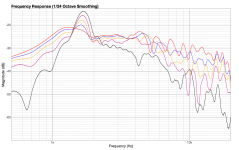
This was measured with the driver mounted slightly recessed on top of the SEAS and with a small rounded cardboard baffle (pics of the setup will follow). Obviously, the Aura has two serious problems when used as a dipole: The peak at 1.6 kHz which is caused by a pipe resonance due to the rear design of the Aura (showing primarily at angles above 15°), and the early dipole peak at around 4.3 kHz caused by the length of its enclosure (i.e. effective baffle). After the peak it becomes nearly unusable directivity-wise.
Correcting the first peak via EQ probably wouldn't be a good idea since that would reduce front radiation as well - am I right about this? The dipole peak can't be transferred much higher (even if I remove the small additional baffle) due to the Aura's enclosure, and stuffing it with damping material would destroy its dipole character if it's effective at all.
In addition, if I would use both drivers together, crossing at a higher frequency to avoid the first peak altogether doesn't seem to be an option, too, because of the SEAS's behaviour above 1.4 kHz.
So basically this means: Not a good combination for an open baffle speaker. 🙁 Or am I missing something here?
The next questions for me now are:
Any ideas?
As promised, here are the measurements for the drivers left over from an abandoned Linkwitz Pluto project. Both have been measured from 1 m with 3,5 ms gating; FR is shown for 0°, 30°, 45°, 60° and 90°, 1/24 octave smoothing.
First the SEAS L16RN-SL:

It shows pretty decent directivity up to 1.4 kHz; above that, things get messy. Also, distortion has a nasty peak just above that frequency. (Of course bass is lost in the graph due to the narrow gating.) Apart from that, the SEAS seems quite usable.
Next the Aura NSW2:

This was measured with the driver mounted slightly recessed on top of the SEAS and with a small rounded cardboard baffle (pics of the setup will follow). Obviously, the Aura has two serious problems when used as a dipole: The peak at 1.6 kHz which is caused by a pipe resonance due to the rear design of the Aura (showing primarily at angles above 15°), and the early dipole peak at around 4.3 kHz caused by the length of its enclosure (i.e. effective baffle). After the peak it becomes nearly unusable directivity-wise.
Correcting the first peak via EQ probably wouldn't be a good idea since that would reduce front radiation as well - am I right about this? The dipole peak can't be transferred much higher (even if I remove the small additional baffle) due to the Aura's enclosure, and stuffing it with damping material would destroy its dipole character if it's effective at all.
In addition, if I would use both drivers together, crossing at a higher frequency to avoid the first peak altogether doesn't seem to be an option, too, because of the SEAS's behaviour above 1.4 kHz.
So basically this means: Not a good combination for an open baffle speaker. 🙁 Or am I missing something here?
The next questions for me now are:
- Is there another tweeter that a) has better dipole behaviour and b) can be crossed as low as 1.4 kHz? The latter criterion rules out the Neo 3, I guess...
- If low XO to the tweeter isn't an option, what would be a good replacement for the SEAS? It would have to be a midwoofer that goes roughly from 200 Hz to 2.5 kHz.
Any ideas?
I've found that a 5" (15 cm) Seas has a really good directivity up to 1.7 kHz. XO at 1.7 kHz is quite possible with an almost perfect off-axis response, making it a bit easier to find a good tweeter. 5" may be a bit small for going down to 200 Hz, but you can compensate by using two (or more) drivers.
Dipole tweeter: there's not really any alternatives to a good AMT....
Dipole tweeter: there's not really any alternatives to a good AMT....
Thanks, StigErik, for the suggestion! Which driver(s) exactly have you tried? I'm asking since the Excel series will quite probably beyond my budget...
I've read good things about the Peerless Exlusive 8380882 (7"), which are being used in the NaO Mini if I remember correctly - any opinion about that?
Speaking of using more drivers: Would it be an option to combine the L16 with another midrange driver for higher frequencies, or is it bad advice to mix drivers in the midrange?
And as for the tweeters: AMTs might also clash with my budget limits - are there any relatively modest options that wouldn't sacrifice too much quality?
I've read good things about the Peerless Exlusive 8380882 (7"), which are being used in the NaO Mini if I remember correctly - any opinion about that?
Speaking of using more drivers: Would it be an option to combine the L16 with another midrange driver for higher frequencies, or is it bad advice to mix drivers in the midrange?
And as for the tweeters: AMTs might also clash with my budget limits - are there any relatively modest options that wouldn't sacrifice too much quality?
I'm using the Excel W15CH001. Expensive stuff indeed, but very good. Its the best driver I've ever measured or listened to for use below 2 kHz.
A budget option could be the very nice Seas CA15RLY or ER15RLY.
A 6" og 7" is a bit too big if you want well behaved directivity up to 1500 Hz.
With a 5" you might be able to use the Neo3, XO at 2 kHz or so. A possibility is also an even smaller midrange than 5" to push the XO freq up.
A budget option could be the very nice Seas CA15RLY or ER15RLY.
A 6" og 7" is a bit too big if you want well behaved directivity up to 1500 Hz.
With a 5" you might be able to use the Neo3, XO at 2 kHz or so. A possibility is also an even smaller midrange than 5" to push the XO freq up.
I'll probably try this one: http://bmsspeakers.com/fileadmin/bm...drivers/neodymium/5_8_12/bms_5n155_t_data.pdf
It's about 85 euro's in Germany.
This driver has high sensitivity, high power handling and sufficient excursion capabilities to be used in an unbaffled configuration down to below 300 hz.
If the rear construction of this driver doesn't mess up rear radiation too bad, it could be a perfect match with the Neo3W tweeter.
It's about 85 euro's in Germany.
This driver has high sensitivity, high power handling and sufficient excursion capabilities to be used in an unbaffled configuration down to below 300 hz.
If the rear construction of this driver doesn't mess up rear radiation too bad, it could be a perfect match with the Neo3W tweeter.
Thanks, StigErik and keyser, for the suggestions! I'd love to see some measurements if you try the BMS. Magnet mounting (which I intend to do in the final design) seems a bit difficult with its rear construction, though...
I compared the available data for the SEAS ER15RLY and the (discontinued, but still available) Peerless HDS 830882, both 5" drivers. They seem pretty comparable, the Peerless showing a bit less distortion (apart from a peak at 450 Hz). Has anyone compared both drivers in measurements and/or listening? (Apart from Zaph, of course...) They both seem attractive options in my price range.
And, as promised, a few pics of the testing configuration I put together yesterday:
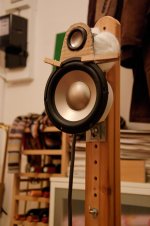
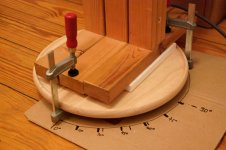
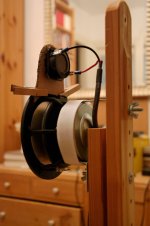
I compared the available data for the SEAS ER15RLY and the (discontinued, but still available) Peerless HDS 830882, both 5" drivers. They seem pretty comparable, the Peerless showing a bit less distortion (apart from a peak at 450 Hz). Has anyone compared both drivers in measurements and/or listening? (Apart from Zaph, of course...) They both seem attractive options in my price range.
And, as promised, a few pics of the testing configuration I put together yesterday:



Just stumbled upon yet another contender for the midbass section: The SB Acoustics SB15NRX30-8. It seems to have lower distortion above 200 Hz than the SEAS and extends a bit further with good off-axis response, though with a minor dip around 1.7 kHz and more severe breakup. Here in Germany both drivers cost around € 55.
I don't know if this can be a valuable hint at how good the drivers match, but I did a quick composite of Zaph's distortion measurements of the SEAS and SB Acoustics on the one hand and of the Neo3 on the other - this is what they look like (SEAS ER15RLY first, SB Acoustics second; switch to the Neo3 is at 2 kHz):
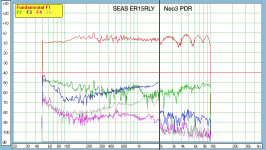
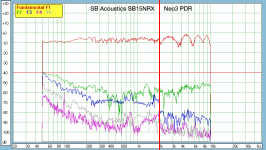
(Huge thanks, of course, to Zaph for his fantastic site!)
Any opinions on that?
And maybe some comments on the importance of low NLD, masking effects and levels at which distortion will become problematic with music instead of test signals? I began reading up on this but still am quite a noob about the finer points of the discussion...
I don't know if this can be a valuable hint at how good the drivers match, but I did a quick composite of Zaph's distortion measurements of the SEAS and SB Acoustics on the one hand and of the Neo3 on the other - this is what they look like (SEAS ER15RLY first, SB Acoustics second; switch to the Neo3 is at 2 kHz):


(Huge thanks, of course, to Zaph for his fantastic site!)
Any opinions on that?
And maybe some comments on the importance of low NLD, masking effects and levels at which distortion will become problematic with music instead of test signals? I began reading up on this but still am quite a noob about the finer points of the discussion...
Neo3W
Back with the next driver!
I received my pair of Neo3W (non-PDR) from Parts Express this week (and received it surprisingly quick, I have to add), removed the back cup and took some measurements (baffle-less, gated, distance 1m, 0° to 90° in 15° steps):
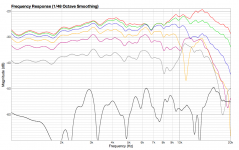
I was (pleasantly) surprised by two findings:
First, working as a dipole, the Neo3 goes down quite low - it's down only 5 dB @ 1 kHz! And that's backed up by the distortion measurements (not shown) - 2nd and 3rd harmonics are at acceptable levels even well below 1 kHz. (Measured at only 70 dB SPL, I have to add, so I'll have to do some more realistic measuring...)
Second, beaming sets in relatively late - I see nice constant directivity up to around 7-8 kHz (apart from the known on-axis dip around 7 kHz). I chose the non-PDR version (which doesn't seem to be available in Germany, btw, hence PE) to avoid diffraction issues and expected to get worse dispersion at lower frequencies than that, so I'm quite happy.
Two questions remain - maybe someone can constribute something useful:
What's causing the huge dip at 11 kHz 45° off axis? Could it be the small cardboard baffle on top which the Neo3 is mounted?
How low can I cross the Neo3? The measurements suggest I could go as low as 1.2 kHz, which would give me some freedom when crossing to the SEAS L16 that have severe distortion issues above 1.4 kHz due to material resonances. Has anybody experience with the Neo3 crossed at such low points? (I know, SL's measurements seem to suggest that this wouldn't be a good idea...)
Next up: Experimental integration with the SEAS L16. But first I have to do some SPL calculations, wait for my DCX2496, build my first Amp - ah, and there's Easter coming up...
Back with the next driver!
I received my pair of Neo3W (non-PDR) from Parts Express this week (and received it surprisingly quick, I have to add), removed the back cup and took some measurements (baffle-less, gated, distance 1m, 0° to 90° in 15° steps):

I was (pleasantly) surprised by two findings:
First, working as a dipole, the Neo3 goes down quite low - it's down only 5 dB @ 1 kHz! And that's backed up by the distortion measurements (not shown) - 2nd and 3rd harmonics are at acceptable levels even well below 1 kHz. (Measured at only 70 dB SPL, I have to add, so I'll have to do some more realistic measuring...)
Second, beaming sets in relatively late - I see nice constant directivity up to around 7-8 kHz (apart from the known on-axis dip around 7 kHz). I chose the non-PDR version (which doesn't seem to be available in Germany, btw, hence PE) to avoid diffraction issues and expected to get worse dispersion at lower frequencies than that, so I'm quite happy.
Two questions remain - maybe someone can constribute something useful:
What's causing the huge dip at 11 kHz 45° off axis? Could it be the small cardboard baffle on top which the Neo3 is mounted?
How low can I cross the Neo3? The measurements suggest I could go as low as 1.2 kHz, which would give me some freedom when crossing to the SEAS L16 that have severe distortion issues above 1.4 kHz due to material resonances. Has anybody experience with the Neo3 crossed at such low points? (I know, SL's measurements seem to suggest that this wouldn't be a good idea...)
Next up: Experimental integration with the SEAS L16. But first I have to do some SPL calculations, wait for my DCX2496, build my first Amp - ah, and there's Easter coming up...
Depends on what you consider to be acceptable distortion and what the crossover is. From my on axis measurements (attached) and subjective experience I'd stick with the usual lower limit of 1.8-2kHz. I've tried crossing as low as 1.5kHz LR6 but found the sound started to get muddy. Depending on your preferences that may or may not sound better than the L16s though, so some experimentation is probably in order.How low can I cross the Neo3?
Have you considered the Neo8 or Neo10 as a midrange? Won't go as low as a midbass but in exchange you get easier integration with the Neo3 and better front/back wave symmetry.
Attachments
Thanks for the reply and the measurement graphs. I'll see what I can do with my L16s - their distortion above 1.4 kHz is at least as bad as the Neo3's.
I guess I'll have to change my mid and midbass arrangement at some point, but I'd like to keep a 3-way setup as long as possible, and adding a Neo8 or Neo10 for mids would mean 4-way if I stick to my RiPole plans for the bass department... Ah, trade-offs.
I guess I'll have to change my mid and midbass arrangement at some point, but I'd like to keep a 3-way setup as long as possible, and adding a Neo8 or Neo10 for mids would mean 4-way if I stick to my RiPole plans for the bass department... Ah, trade-offs.
Indeed, three way dipoles all seem to involve some amount of contortion somewhere. Hence I planned my build as a four way from the start. But one option I find tempting for two and three way dipoles is, rather than resorting to paired dynamic tweeters or an AMT, to sacrifice the high end response and use the Neo8 as a midtweeter. Haven't ever tried it but, in principle, having directionality and EQ challenges above 10kHz is probably better than bombing out at 1.5kHz.
Basotect to the rescue
Next iteration: A little Basotect (open-cell foam) around the driver and some more measurements.

The on-axis dip around 7 kHz is gone, only the more broadband dip between 5 and 8 kHz and the associated directivity increase are left. Has anyone been able to reduce these further?
The other thing on my mind is distortion - I ran a distortion measurement at a more realistic SPL level, and the graph clearly shows a peak at 1.7 kHz.
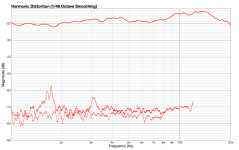
A good reason to cross higher - if the SEAS L16 didn't have an even higher peak at the same frequency... Further experimentation will follow as soon as DCX2496 and amps are ready.
Next iteration: A little Basotect (open-cell foam) around the driver and some more measurements.

The on-axis dip around 7 kHz is gone, only the more broadband dip between 5 and 8 kHz and the associated directivity increase are left. Has anyone been able to reduce these further?
The other thing on my mind is distortion - I ran a distortion measurement at a more realistic SPL level, and the graph clearly shows a peak at 1.7 kHz.

A good reason to cross higher - if the SEAS L16 didn't have an even higher peak at the same frequency... Further experimentation will follow as soon as DCX2496 and amps are ready.
Has anyone tried Zaph's babies (ZA14W08) in OB ? They look like cheap(er) alternative to Excel drivers, and seem to be punching well above their price range. Stiff cone, shorting rings, reasonable sensitivity, resonances well up into 7+ kHz ...
Not sure how is big magnet affecting (or not) radiation in the back.
Not sure how is big magnet affecting (or not) radiation in the back.
IIRC, yes. Check cuibono's polars in the Violet DSP thread here and saurav's polars in his OB thread at HT Guide.Has anyone been able to reduce these further?
Considered and rejected them. Nearly all small woofers are pretty constricted on the backwave. I'm running some vented pole piece eights at the moment. Weather's been no good for proper measurements but they sound noticeably more consistent to the rear than the unvented sixes I was using previously.Has anyone tried Zaph's babies (ZA14W08) in OB?
I thought about the ZA14s as a possible replacement for the L16s, too - seem to have good directivity characteristics at the top end, plus a higher dipole peak due to the smaller effective path difference. Xmax and Sd should be sufficient for crossing to them at around 200 Hz.
I see your point, but doesn't that come at the expense of worse horizontal dispersion when compared to smaller drivers? How high are you crossing from the 8s?
Considered and rejected them. Nearly all small woofers are pretty constricted on the backwave. I'm running some vented pole piece eights at the moment. Weather's been no good for proper measurements but they sound noticeably more consistent to the rear than the unvented sixes I was using previously.
I see your point, but doesn't that come at the expense of worse horizontal dispersion when compared to smaller drivers? How high are you crossing from the 8s?
- Status
- Not open for further replies.
- Home
- Loudspeakers
- Multi-Way
- Driver evaluation for OB project

